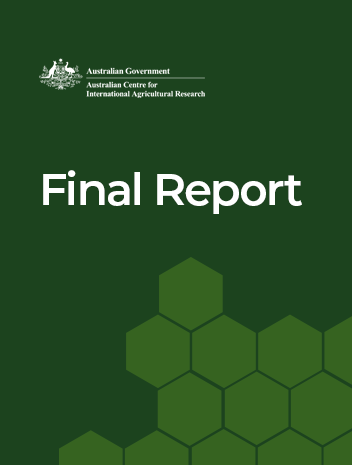- HomeHome
-
About ACIAR
- Our work
- Our people
-
Corporate information
- ACIAR Audit Committee
- Commission for International Agricultural Research
- Policy Advisory Council
- Agency reviews
- Executive remuneration disclosure
- Freedom of information (FOI)
- Gifts and benefits register
- Information publication scheme
- List of new agency files
- Contracts
- Legal services expenditure
- Privacy impact assessment register
- Commonwealth Child Safe Framework
- Benefits to Australia
- Careers
- 40 years of ACIAR
-
What we do
- Programs
- Cross-cutting areas
- Resources
- Where we work
-
Funding
- Research projects
- Fellowships
-
Scholarships
- John Allwright FellowshipScholarships to study in Australia for ACIAR partner country scientists to have Australian postgraduate qualifications
- ACIAR Pacific Agriculture Scholarships and Support and Climate Resilience Program
- Alumni Research Support Facility
- Publications
- News and Outreach
Project final report
Managing basal stem rot in oil palm by converting infected logs to biochar - Final Report
Date released
16 May 2023
ISBN
978-1-922983-14-5
Publication Code
FR2023-020
Overview
This project aimed to critically assess the conversion of oil palm waste into biochar in Papua New Guinea. Biochar is a charcoal-like material made via the pyrolysis of organic biomass (i.e., heating of biomass under low or no oxygen conditions). Pyrolysis has long been a part of renewable energy systems, generating syngas, bio-oils, and heat.
Oil palm (Elaeis guineensis Jacq.) is a long-term perennial crop of great economic importance to many countries in tropical Asia/Oceania and is economically the most important agricultural commodity in Papua New Guinea (PNG). It provides export revenue and much needed income to both large plantations and smallholders. Unfortunately, basal stem rot (BSR), caused by the fungus Ganoderma boninense Pat., poses a major threat to the oil palm industry and hence to farmers’ livelihoods.
Loss of revenue due to pests and disease in oil palm is of great concern both at a local and national level. The most economically significant disease in PNG is basal stem rot (BSR) which causes palm death and thus a decline in incomes, at both local and national scale. The only viable long-term control of BSR is through the use of tolerant planting material, combined with sanitation measures to reduce the carry-over of the pathogen from older, infected trees to neighbouring palms and new plantings.
We tested 2 technologies for making biochar: a low-cost flame curtain pyrolysis unit called Kon Tiki which can be manufactured in developing countries for about 1,000 AUD, and a commercially available, highly engineered, transportable pyrolysis unit called Big-Roo (approx. cost AUD40,000). We demonstrated that biochar made with both technologies promoted growth of common vegetable seedlings in both a commercial nursery in Australia and under local PNG conditions, indicating that oil palm residue could be a good clean feedstock for pyrolysis. Biochar from oil palm residues has the potential to contribute to a more circular economy by converting waste into a higher value product, which may be sold for profit and thus increase smallholders’ income.



